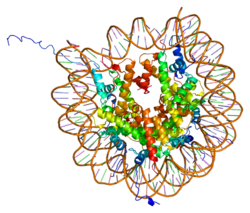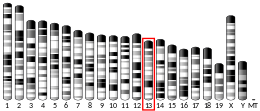Histone H2B type 1-C/E/F/G/I is a protein that in humans is encoded by the HIST1H2BC gene .[ 5] [ 6] [ 7]
H2BC4 Identifiers Aliases H2BC4 External IDs OMIM : 602847 ; MGI : 2448386 ; HomoloGene : 136774 ; GeneCards : H2BC4 ; OMA :H2BC4 - orthologs Wikidata
Histones are basic nuclear proteins that are responsible for the nucleosome structure of the chromosomal fiber in eukaryotes. Two molecules of each of the four core histones (H2A, H2B, H3, and H4) form an octamer, around which approximately 146 bp of DNA is wrapped in repeating units, called nucleosomes. The linker histone, H1, interacts with linker DNA between nucleosomes and functions in the compaction of chromatin into higher order structures. This gene is intronless and encodes a member of the histone H2B family. Transcripts from this gene lack polyA tails but instead contain a palindromic termination element. This gene is found in the large histone gene cluster on chromosome 6.[ 7]
^ a b c GRCh38: Ensembl release 89: ENSG00000180596 – Ensembl , May 2017^ a b c GRCm38: Ensembl release 89: ENSMUSG00000058385 – Ensembl , May 2017^ "Human PubMed Reference:" . National Center for Biotechnology Information, U.S. National Library of Medicine .^ "Mouse PubMed Reference:" . National Center for Biotechnology Information, U.S. National Library of Medicine .^ Albig W, Kioschis P, Poustka A, Meergans K, Doenecke D (Apr 1997). "Human histone gene organization: nonregular arrangement within a large cluster". Genomics . 40 (2): 314– 22. doi :10.1006/geno.1996.4592 . PMID 9119399 . ^ Marzluff WF, Gongidi P, Woods KR, Jin J, Maltais LJ (Oct 2002). "The human and mouse replication-dependent histone genes". Genomics . 80 (5): 487– 98. doi :10.1016/S0888-7543(02)96850-3 . PMID 12408966 . ^ a b "Entrez Gene: HIST1H2BC histone cluster 1, H2bc" .
Ohe Y, Hayashi H, Iwai K (1979). "Human spleen histone H2B. Isolation and amino acid sequence". J. Biochem . 85 (2): 615– 24. doi :10.1093/oxfordjournals.jbchem.a132371 . PMID 422550 . Albig W, Doenecke D (1998). "The human histone gene cluster at the D6S105 locus". Hum. Genet . 101 (3): 284– 94. doi :10.1007/s004390050630 . PMID 9439656 . S2CID 38539096 . El Kharroubi A, Piras G, Zensen R, Martin MA (1998). "Transcriptional Activation of the Integrated Chromatin-Associated Human Immunodeficiency Virus Type 1 Promoter" . Mol. Cell. Biol . 18 (5): 2535– 44. doi :10.1128/mcb.18.5.2535 . PMC 110633 PMID 9566873 . Deng L, de la Fuente C, Fu P, et al. (2001). "Acetylation of HIV-1 Tat by CBP/P300 increases transcription of integrated HIV-1 genome and enhances binding to core histones" . Virology . 277 (2): 278– 95. doi :10.1006/viro.2000.0593 PMID 11080476 . Deng L, Wang D, de la Fuente C, et al. (2001). "Enhancement of the p300 HAT activity by HIV-1 Tat on chromatin DNA" . Virology . 289 (2): 312– 26. doi :10.1006/viro.2001.1129 PMID 11689053 . Strausberg RL, Feingold EA, Grouse LH, et al. (2003). "Generation and initial analysis of more than 15,000 full-length human and mouse cDNA sequences" . Proc. Natl. Acad. Sci. U.S.A . 99 (26): 16899– 903. Bibcode :2002PNAS...9916899M . doi :10.1073/pnas.242603899 PMC 139241 PMID 12477932 . Lusic M, Marcello A, Cereseto A, Giacca M (2004). "Regulation of HIV-1 gene expression by histone acetylation and factor recruitment at the LTR promoter" . EMBO J . 22 (24): 6550– 61. doi :10.1093/emboj/cdg631 . PMC 291826 PMID 14657027 . Ewing RM, Chu P, Elisma F, et al. (2007). "Large-scale mapping of human protein–protein interactions by mass spectrometry" . Mol. Syst. Biol . 3 (1): 89. doi :10.1038/msb4100134 . PMC 1847948 PMID 17353931 .
PDBe-KB provides an overview of all the structure information available in the PDB for Human Histone H2B type 1-C




